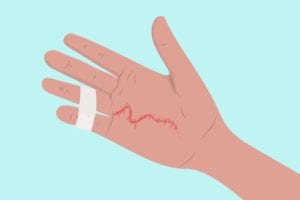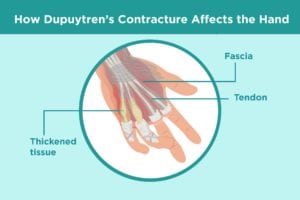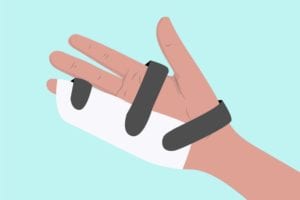If any of your fingers, particularly your ring or pinky fingers, are stuck in a bent or crooked position, it is possible you are experiencing what is known as Dupuytren’s contracture, or Dupuytren’s disease. This is also commonly referred to as trigger finger.
What Is Dupuytren’s Contracture?
Dupuytren’s contracture is a hand deformity that develops over a span of several years and is not dangerous, although it can be rather awkward or inconvenient, and it can return after treatment. When you have Dupuytren’s, too much collagen builds up in the hand and your body is not able to properly break it down. The excess collagen forms into hard bumps or chords that pull on the fingers, leaving them stuck in a bent position.
Dupuytren’s can affect any of your fingers, but is more likely to affect the ring and pinky finger. This can make everyday tasks that require normal use of your hand very difficult.
What Living with Dupuytren’s Contracture Feels Like
Because Dupuytren’s is not considered dangerous, many people ignore the early symptoms and opt out of getting a medical diagnosis or treatment. However, Dupuytren’s can have a significant impact on day-to-day life, making simple or mundane tasks incredibly difficult. Dupuytren’s can permanently reduce the normal functions of the ring and pinky fingers, which makes it very difficult to grip, hold, turn, or use most handheld items. Dupuytren’s can have a severely negative impact on work, use of cellphones, driving, exercise, cooking, cleaning, and much more.
If you suspect you could have Dupuytren’s contracture, it’s important to see a doctor so you can get a proper diagnosis and discuss your treatment options. The goal of Dupuytren’s treatment is to break up or dissolve the overwhelming buildup of collagen in your hand to regain use of your fingers.
None of the currently available options addresses the underlying cause of Dupuytren’s, which comes from the body’s overproduction of collagen and inability to break down old collagen properly; therefore, treatments are not a cure. However, many people who undergo treatment do not have recurring symptoms.
Dupuytren’s Treatment Options
There are two main types of treatment for Dupuytren’s: collagenase injections and surgery. Below is a detailed analysis of both treatments, giving patients an in depth look at both options, as well as information on a few other recognized treatment options.
Dupuytren’s Treatment: CCH Collagenase Injection
A common alternative to surgery (more on this below) for Dupuytren’s is an injectable form of collagenase clostridium histolyticum (CCH), which is an enzyme extracted from bacteria. These enzymes break down the collagen buildup in the hand that causes lumps and chords in Dupuytren’s.
Xiaflex is the only CCH injection on the market. It shows low recurrence rates of Dupuytren’s contracture and often provides fast, effective results. Patients receive a CCH injection dosage of varying volume and potency, depending on the location of the chords and contracture. Normally, patients receive one injection per localized collagen buildup, or one per affected joint/finger. Patients are then typically given a splint to help regain finger extension. Within a few days of receiving the injection, patients meet with the doctor who will then further the breakup and dissolvement of the collagen through manipulations or massages to the hand while you’re under local anesthesia.
Over the last decade, CCH injection has become a more popular form of treatment for mild as well as advanced cases of Dupuytren’s than surgery. According to a Dupuytren’s treatment research study published in the journal HAND in 2016, CCH injection treatment has increased significantly since its FDA approval in 2010 and increased proportionately to the decrease in palmar fasciectomy (the most common surgical procedure for treating Dupuytren’s).
CCH injections are cheaper and more convenient than surgical fasciectomy. On average, injections require significantly fewer trips to the hospital, doctor, or physical therapist than the surgical alternative. According to a study published in the American Journal of Managed Care, patients who are treated using CCH injections spent far less money (more than $600 less) both initially and annually following treatment than fasciectomy patients.
The cost, usually covered by insurance, is about $4,000. The drug also has a copay card covering up to $1,200 of out of pocket expenses for eligible patients. Eligibility requirements include:
- At least 18 years of age
- Eligible and approved for Xiaflex treatment itself
- Are uninsured or have insurance that is not provided by Medicare, Medicare Prescription Drug Benefit plans, Medicare Advantage, Veterans Affairs (VA), Medicaid, or similar federal or state programs
- Program is not otherwise prohibited by law

Dupuytren’s Treatment: Open Surgery
For many years, surgical fasciectomy was the standard treatment for Dupuytren’s contracture and remains a reliable option for advanced and severe cases. Fasciectomy is a surgery that removes layers of the fascia, which is the tissue in the hand that becomes hard and chord-like from having Dupuytren’s contracture.
During the surgery, an incision is made in the hand and pieces of the hardened chords are removed. Patients who undergo surgery can expect to be out of work for several weeks, depending on how much they use that hand. Most doctors prescribe pain medication following surgery. Stitches often come out two weeks following the operation. After removal of the stitches, patients should receive physical therapy, which can last for several months. Patients will do exercises that extend and strengthen their fingers and hands to regain optimal use of their hand. Many patients wear a hand splint for several weeks to aid in this process.
Surgery is a more expensive and time-consuming option than CCH injections. Annual cost of the surgery can be $5,000 to $6,000, as opposed to roughly $4,000 for CCH injections. Both procedures are normally covered by insurance. Although the number of patients who opt for surgical fasciectomy has declined over the last decade, surgery is still a reliable and practical option for many patients with advanced cases of Dupuytren’s. However, scar tissue and distortion of natural anatomy after surgery can make future hand surgery more difficult if Dupuytren’s comes back.
Other Dupuytren’s Treatment Options
Although CCH Injections and surgery are widely regarded as the two most effective Dupuytren’s treatment options, they are not the only options. Here are others you might discuss with your doctor:
Needle aponeurotomy: This is the process of breaking up chords and lumps from Dupytren’s by inserting a needle into the tissue buildup and extending or contracting the fingers to break up the collagen formations. First, local anesthesia is applied to numb the hand. Then, a series of needles are inserted into the hand into the chords or bumps. The hand and fingers are then manipulated to break up the collagen.
This form of treatment is convenient because it can be administered directly in a doctor’s office, with a significantly lower cost than either surgery or CCH injections. Also, the recovery time is much shorter, typically a few days or until the swelling is gone.
However, needle aponeurotomy is not nearly as effective as CCH injections or surgery. A study concluded that after only five years, roughly eight in 10 patients saw a return of Dupuytren’s contracture after needle aponeurotomy, as opposed to only two in 10 patients seeing a return of the contracture after surgery, or three in ten patients seeing a contracture recurrence after CCH injections.
Needle aponeurotomy may be a better Dupytren’s treatment option if a patient’s condition is very mild, or if they are unable to have surgery or injections due to other health risks. Risks to consider when thinking about needle aponeurotomy are cracking of the skin, minor nerve or tendon damage, or a possible infection. The most important risk to consider, however, is the lack of success attributed to needle aponeurotomy in treating Dupuytren’s.
Corticosteroid injections: Used for various orthopedic problems, cortisone injections reduce inflammation, which often reduces pain (although cortisone itself is not a painkiller). For treating Dupuytren’s, cortisone injections are administered during the nodule, or hard bump, stage. The goal is to reduce the inflammatory nature of the nodules and therefore stop the disease in its tracks.
However, this is not a very effective form of treatment because many patients see the nodules return shortly after treatment. Along with documented ineffectiveness, cortisone injections also come with potential side effects, such as elevated blood sugar, tendon rupture, or skin pigment changes. Because of these factors, cortisone steroid injections are rarely done for treating Dupuytren’s.
There are also a few last-resort options for Dupuytren’s, although these are rare and will only be administered if a long, aggressive battle against Dupuytren’s is unsuccessful. These options include:
- Joint fusion: A joint is permanently set in place so the bone grows across and will therefore no longer contract.
- External fixation: A device is attached to the bone to stretch soft tissue over a long period of time and potentially loosen the contracture.
- Amputation: Although extremely rare, removal of a finger can potentially help in the direst of circumstances.
Although the cause of Dupuytren’s is unknown, there are things you can do to lessen the likelihood of recurrence and limit the need for repeated treatment for Dupuytren’s. Quitting smoking and reducing alcohol intake are two of the biggest factors in preventing the recurrence of Dupuytren’s.
Ultimately, there is a chance that some form of Dupuytren’s will return. For now, treating Dupuytren’s is the most effective way to regain hand use, but because of effective treatment options like CCH injections and surgery, and ongoing research into the cause of Dupuytren’s, it is a disease more and more people comfortably live with.







